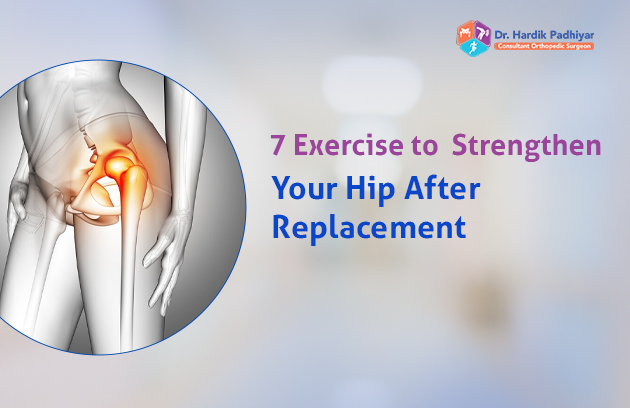Recovering from a hip replacement service in Ahmedabad involves a combination of rest, rehabilitation, and carefully planned exercises. It is always advisable to consult a doctor before incorporating these exercises into your regular routine, as they will be effective in enhancing the strength and flexibility of individuals in the process of recovery.
Dr. Hardik Padhiyar, best orthopedic surgeon in Ahmedabad, answers questions about how walking exercise plays a critical role in the rehabilitation process of hip replacement.
Table of Contents
Toggle1. Ankle Pumps
Purpose: Improve circulation and reduce swelling.
How to Perform:
– Lie on your back with your legs extended.
– Flex your ankles, pulling your toes toward your head.
– Then, point your toes away from your head.
– Repeat this motion 10-15 times for each ankle.
Benefits:
– Enhances blood flow.
– Reduces the risk of blood clots.
– Maintains ankle mobility.
2. Quad Sets
Purpose: To strengthen the quadriceps muscles.
How to Perform:
– Lay down with your legs straightened or sit in a sitting position.
– Squeeze and pull the back of your knee towards the floor if you are to increase the pressure on your quadriceps muscle.
– Now you need to learn how to feel a contraction, try to hold the contraction for 5 seconds and then relax.
– Perform each leg 10-15 sets of this exercise.
Benefits:
– Helps to stabilise the nerves around the knee joint as well as the muscles that support it.
– Reduces pressure on your new hip joint and strengthens muscles surrounding this joint.
3. Glute Sets
Purpose: To Strengthen the gluteal muscles are recommended:
How to Perform:
– Begin the exercise while lying down on a flat surface with your arms at your side and your legs stretched out.
– Tighten the muscles in your backside as if you are trying to hold something between them or are sitting on an egg.
– Take a pause of five seconds; now, release your muscles.
– This entire exercise should be performed 10-15 times.
Benefits:
– Raises the buttocks, which strengthens the gluteal muscles.
– It is used in the support of hip function, as well as the mobility of the affected area.
4. Heel Slides
Purpose: Reduce stiffness in the knee and hip joints.
How to Perform:
– Start in a supine position with your legs in line with your body’s long axes.
– Lower your body slowly and carefully, shifting your weight to the heel to bend the knee.
– Return back to the initial position by shifting the heel as far forward as possible to the rear stop.
– Do this exercise for 10-15 cycles for each leg.
Benefits:
– Knee and hip flexor strengthens and improves the scope of movement.
– In general, this particular component is used in enhancing flexibility and mobility at the joints.
5. Hip Abductions
Purpose: Improve the strength of muscles, or hip abductor muscles.
How to Perform:
– Starting off, lay flat on your back with your legs stretched out on the floor.
– Stand erect with your feet shoulder width apart and then with a rigid posture try to take your legs to the side as much as you can.
– The last position and bring the leg back to the midline of the body.
– Perform 10-15 operating circles for each leg.
Benefits:
– Strengthen the muscles that pull the leg in a direction that is away from the side of your body.
– It helps in reducing risks of developing a poor balance, and therefore reducing the chances of falling.
6. Standing Hip Flexion
Purpose:Strengthen hip flexor muscles.
How to Perform:
– Preferably stand with your legs slightly apart and Parallel to each other.
– It is recommended that you grab a chair or a countertop so as to maintain balance during the exercises.
– Very gently, bring one knee up toward your chest while still retaining the correct sitting position with the back straight.
– Bend your knees and bring your leg down while making sure that your other leg stays straight.
– The exercise should be done 10-15 times each for the legs.
Benefits:
– Builds the hip flexion muscles that are found in the anterior part of the hip joint.
– Stimulates walking and overall functioning.
7. Standing Hip Extension
Purpose: To be able to reduce the stress in joints of the lower limbs during jump it is necessary to strengthen hip extensor muscles.
How to Perform:
– By standing legs apart but close enough to be parallel with the shoulders it will help in gaining a strong stance.
– It may be slightly uncomfortable, but it gets the job done: grab a chair or counter to steady yourself.
– Hold your chopsticks vertically on a plate and slowly raise one of your legs off the ground while keeping your knee straight.
– Bring your leg slowly back down.
– Perform 10-15 cycles each for the right and left leg, respectively.
Benefits:
– This exercise is very effective in strengthening the muscles that are at the backward part of the hip.
– Tends to enhance abilities to walk or stand firmly.
Conclusion
The process of recovery following hip replacement service in Ahmedabad also slow and patients need to have a schedule that they should follow so as to re-gift their hips well. If you integrate the seven exercises explained in this post into your training regimen, you should do it with the assistance of Dr. Hardik Padhiyar, a proficient hip replacement surgery specialist based in Ahmedabad. It is advisable to consult with the best orthopedic doctor in Ahmedabad before engaging in any exercise regime especially if you have any orthopedic related ailment.
By considering his knowledge and experience and because of the ample support that hip replacement specialist in Ahmedabad offer for the people the patients can regain his or her normal functionality and actively resume his or her regular duties.






